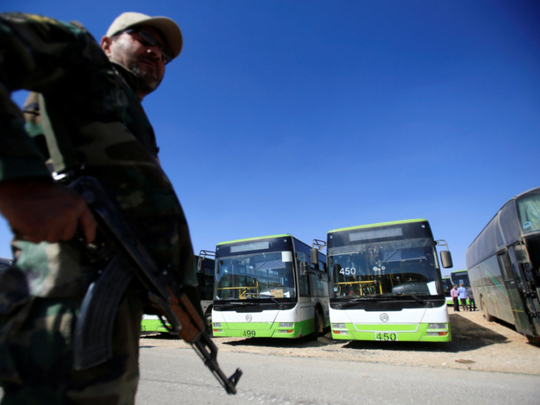
Beirut: For the second time a matter of weeks, thousands of rebel fighters and civilian refugees who had found a haven in Lebanon are being sent back to Syria to live in what is being billed as a “safe zone” in the war-torn country.
Depending on the point of view, the transfers are humanitarian gestures to people longing to return home, a security measure to protect Lebanon from extremists or a forceful removal of vulnerable refugees that could herald wider-scale expulsions.
Thousands of Syrians have fled in recent years into Lebanon, where many citizens have grown increasingly tired of hosting the newcomers.
Buses were expected to begin transporting 3,000 Syrian rebel fighters and civilian refugees from a remote area in northeastern Lebanon to Syria on Monday morning.
The transfer was part of an agreement negotiated between Hezbollah — the Iran-backed Lebanese political party and militia — and the group Saraya Ahl Al Sham, which is affiliated with the Free Syrian Army rebel coalition.
Saraya Ahl Al Sham hopes to dislodge Syrian President Bashar Al Assad from power. Hezbollah supports Al Assad.
Lebanon’s state news agency said on Sunday that 35 buses and a fleet of ambulances had arrived in Arsal to take about 400 militants — who were described as “armed terrorists” — and their families to the rebel-controlled Syrian town of Ruhaiba, about 30 miles northeast of Damascus.
It’s estimated that 350 to 400 people to be transferred this week are rebels who have been fighting against Al Assad government; the rest are family members of the rebels and other civilians.
Khalid Ra’ad, a community leader among the refugees in Arsal who was not among those removed, said on Sunday that there are about 65,000 Syrians remaining in the area, most from the areas of Homs, Quseir and Qalamoun. They want to return home, he said, but not under the present conditions.
“In my opinion, they all want to return to their villages ... but away from Al Assad’s rule — under international patronage and United Nations’ supervision, far from Al Assad’s authority,” he said.
This week’s expulsions come after a separate agreement to return Syrian fighters and refugees to Syria between Hezbollah and Hayyat Tahrir Al Sham, another rebel coalition headed by the Islamist group formerly known as Al Nusra.
Hayyat Tahrir Al Sham also had been operating in the Arsal area, and the group was routed in a military operation headed by Hezbollah last month. That resulted in the deal to transfer an estimated 9,000 insurgents and civilians from Lebanon to rebel-held areas in Syria.
The United Nations Office for the Coordination of Humanitarian Affairs said it was coordinating aid for 5,288 people who had arrived in northwestern Syria from the Arsal area under the earlier deal to transfer 9,000 people. The status of the remaining people was unclear.
In a statement, the UN agency questioned the agreements to return refugees to Syria.
“The UN and the humanitarian community had no part in reaching this agreement and have repeatedly expressed deep concern at the continuing use of such ‘local agreements,’ which do not appear to meet international legal standards or humanitarian principles,” it said. “Such movements should be voluntary and within a conducive protection environment.”
The question of when and how Syrians should return to their country has become a highly charged one in Lebanon, a tiny country that is hosting more than 1 million refugees while its own population is about 4 million.
Increasingly, political leaders — including Lebanese President Michel Aoun — have made calls for the refugees to return home, whether willingly or not. Even before the recent battles, several dozen refugee families had been transported from Arsal back to Syria under yet another arrangement brokered by Hezbollah.
Raad, the refugee community leader in Arsal, said in spite of the increasing pressure, he plans to remain in Lebanon.
“The truth is that there is no law in the United Nations or in the Security Council system or even in international norms or laws that prevents a refugee from deciding to remain,” he said. “Even if there are some pressures, staying is the best decision. ... It’s not possible to send people to their death.”












